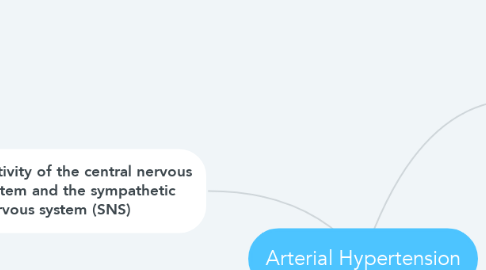
1. Regulation of sodium excretion by the kidneys
1.1. deficient renal excretory function = chronic sustained increase of BP
1.2. Renin Angiotensin Aldosterone System
1.2.1. Induces oxidative stress at tissue level (Activation of oxidases NADH y NADPH) , this produces fuctional and structurals changes (endothelial dysfunction), and makes the hypertensive pathology
1.2.2. the angitensin II's actions incluide: contraction of vascular smooth muscle, stimulation of the synthesis and secretion of aldosterone, vasopressin stimulation/ADH, stimulation of the dipsogenic center in the central nervous system, antagonism of the atrial natriuretic peptide-natural system, increase in endothelin production (ET1) and vasoconstrictor prostaglandins (TXA2, PgF2α)
1.2.3. ACE inhibitor
1.2.3.1. inhibit convertion of angiotensin 1 to angiotensin 2 and avoid inactivation of bradikinin
1.2.4. ARAs
1.2.4.1. Bind to the aldosterone receptors inhibiting expretion of Na+ channels in the late convulated tubules and the collecting ducts
1.3. Diuretics
1.3.1. Thiazides
1.3.1.1. Block Na. Cl sintransporter in the distal convulated tubule cells
1.3.2. Loop diuretics
2. Contractile processes in the vascular tree
2.1. Responds to changes in sodium and potassium concentrations and the transepithelial flow of this ions by altering the production of ASP (arterial stiffness promote)
2.1.1. In circumstances of oxidative stress, reactive oxygen species interact with: 1) BH4, resulting in a decrease in the activity of eNOS and a decreased NO production; 2) DDAH, resulting in the accumulation of ADMA and inhibition of NO production eNOS; 3) the own NO, resulting in the production of the peroxynitrite radical and more reactive oxygen species.
2.1.1.1. inflammation of the vasculation
2.2. Produces local and systemic inflammation, resulting in an increase in factor 3 of the activated complement (C3) and the consequent increase in vascular damage in relation to inflammation and with a decrease in the activity of endothelial progenitor cells
2.2.1. will lead to endothelium-dependent vasomotor dysfunction. Endothelial dysfunction, in turn, can worsen HBP, perpetuating the vicious circle between hypertension and endothelial dysfunction
2.3. CCB
2.3.1. They bind to the epithelial aclcium channels which relaxez smooth muscle generating vasodilation
3. Activity of the central nervous system and the sympathetic nervous system (SNS)
3.1. Control of long term blood pressure
3.1.1. Regulation of the balance between salt and water through the effects of the SNS on renin secretion and renal tubular sodium reabsorption
3.2. The increase in renal nervous sympathetic activity leads to a renal vasoconstriction, with a decrease in the glomerular filtration rate and renal blood flow, and an increase in renal vascular resistance; increase in renal tubular reabsorption of sodium and water through the nephron; and increased renal release of renin and NE.
3.3. Gradual increases in renal sympathetic nervous activity regulate the three main renal neuroeffectors: juxtaglomerular granular cells containing renin, the tubule system and the arterial resistance vasculature.
3.4. Noradrealine-Adrenaline Vasoconstrictor Mechanism
3.4.1. An decrease of BP stimulates the sympathetic nervous system, this stimulates the secretion of noradrenaline and adrenaline from the adrenal medulla, which pass into the bloodstream and cause in it the same effects of direct sympathetic stimulation
3.4.1.1. Beta blockers
3.4.1.1.1. Bind to the A1 receptors inthe heart inhibiting their adrenergic action lowering the chronotropism and inotropism. They affect the CO but no the PVR. They also inhibit renin secretion in the yuxtaglomerular aparatus
